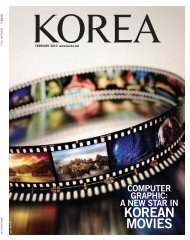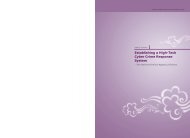KOREAN CINEMA 2 0 0 7
KOREAN CINEMA 2 0 0 7 - Korea.net
KOREAN CINEMA 2 0 0 7 - Korea.net
- No tags were found...
You also want an ePaper? Increase the reach of your titles
YUMPU automatically turns print PDFs into web optimized ePapers that Google loves.
committee of overseas film specialists will be formed, holding meetings among consultants<br />
and specialists from key regions of the world (Americas, Europe and Asia.) Locale offices<br />
at overseas will be established, first with the one in LA in 2007, followed by offices in<br />
Japan, China and France by 2008. In addition, correspondents at three key regions, Tokyo,<br />
Beijing and Paris, will be positioned to provide up-to-date information on film industry<br />
of their prospective regions, along with a network of locale film specialists from 16 key<br />
countries in operation.<br />
Its major support programs are :<br />
Filmmakers Development Lab<br />
Support Program for Overseas Korean Film Festivals<br />
- Japan: Korean Film Showcase<br />
- U.S.A: A Program to Circulate Korean Films in North America<br />
Managing KOFIC Office in LA<br />
Support Program for Overseas Marketing<br />
Building Overseas Networks<br />
- Business R & D Campus<br />
- Asia Film Professional Training Program<br />
Publication of English-language Books on Korean Cinema<br />
DVD Production & Distribution Support for Outstanding Korean Films<br />
Subtitle Translation and Print Production Support Program<br />
Support Program for Korean Filmmakers’ Participation at Global Festival Circuit<br />
- International Producer’s Lab<br />
Support Program for Hub Libraries for Korean Film Studies<br />
3. Korean Film Research Center<br />
By conducting all-around research and policy development on both the domestic and<br />
international multimedia communities, KOFIC presents a policy vision for the bright<br />
future of Korean films. The Korean Film Research Center was created by expanding its<br />
existing Policy Research Department to take up on wider range of programs providing the<br />
sources of vital information in the form of statistics, analysis, and publications for industry<br />
professionals, press, the government, and the general public.<br />
Korean Film Research Center collects statistics on the Korean film industry to examine its<br />
changing nature, presents marketing strategy based on audiences’ viewing inclinations<br />
and demands; plans the strategic foundation for export based on research on overseas<br />
film industries and the current state of Korean films abroad; and implements a network of<br />
KOFIC foreign correspondents to keep track of up-to-the minute trends in the fast-changing<br />
world film community.<br />
Korean Film Research Center also operates a committee to look into the effects and<br />
necessary countermeasures for the merging of media groups, originating a new vision for<br />
the film industry in a newly developing media-merging environment.<br />
Its major support programs are<br />
Designated Research Assignment Support Program<br />
Support Program for New Researchers<br />
Publication Support Program<br />
Support Program for the Publication of Noteworthy Film Books<br />
4. Korean Academy of Film Arts (KAFA)<br />
KAFA was founded as an arm of KOFIC (then the Korean Motion Pictures Promotion<br />
Corporation) in 1984, with the aim to train the human resources necessary to revive a<br />
stagnant film industry, and to overcome the limitations of existing theory-based film<br />
education by offering hands-on training programs.<br />
Since its establishment, KAFA has grown influentially while producing the core talent that<br />
has led the Korean film renaissance that has culminated in the past decade or so. Most of<br />
the 365 graduates, including more than 60 feature film directors, are all presently working<br />
actively in the film industry- in all aspects of the film industry, including the production and<br />
technical areas, academia, and of course as feature-film directors, demonstrating KAFA’s<br />
status and its vital role in the Korean film industry. With their extensive achievements,<br />
KAFA has established a tradition as Korea’s premiere film school, and is aiming to cultivate<br />
human resources for the global filmmaking arena as well.<br />
5. KOFIC Studios<br />
KOFIC post-production facilities in Seoul headquarters and the Studio Complex at<br />
Namyangju are the largest film production facilities in Asia, offering a 30,000 pyong outdoor<br />
set along with six indoor studios in various scales. The studio complex also offers stateof-the-art<br />
recording studio, film processing laboratory, and digital visual effect suite among<br />
other systems that create a central environment in Korean film production. All necessary<br />
production facilities and equipments are provided for production purposes, from on-location<br />
shoots to post-production process that often results in finest Korean films to date. Some<br />
of Korea’s landmark films, from to and from to , all went through skillful hands and technology that KOFIC studios<br />
and post-production facilities offer.<br />
The KOFIC Studios was established in 1997 as the nation’s premiere center for filmmaking.<br />
The 1.3 million m2 complex is made up of indoor and outdoor studios, production<br />
equipment, visual special effects equipment, sound recording facilities, an extensive props<br />
and costume collection, a film laboratory, as well as a film museum and visual education<br />
center for tourists and aspiring filmmakers.<br />
Digital Cinema Project<br />
One of the most significant technological issues facing the Korean film industry is that<br />
of digital cinema. KOFIC is working to promote digital cinema in Korea with the vision of<br />
having more filmmakers being able to make a greater diversity of films, which in turn would<br />
be able to screen to a greater number of diverse audiences.<br />
Film Laboratory<br />
KOFIC puts its best efforts into the strengthening of its post-production capacity while<br />
securing international competitiveness of its media technology.<br />
KOFIC’s film laboratory has been internationally recognized with a Kodak Image Care<br />
Program certificate of excellence. The 1,500 m2 laboratory has a work capacity of 15 million<br />
ft for features and 5 million ft for shorts per year. The KOFIC Film Lab, which opened on<br />
June 24 th<br />
1980, has been developing and printing over 50 million ft of film annually,<br />
entrusted with approximately 30% of Korean films produced. The laboratory features<br />
developing & processing lab, special effects printing room, color correction lab, telecine<br />
room, film cleaning room, test lab and a screening room.<br />
For more detailed information on KOFIC Support Programs,<br />
please visit KOFIC website (www.kofic.or.kr/english)<br />
12 13
















